Petropavlovsk class battleships (1894)
 Russia (1894)
Russia (1894)
Battleships – Petropavlovsk, Poltava, Sevastopol
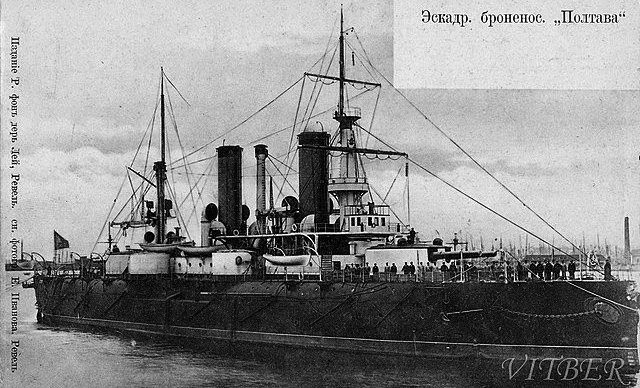
Victims of the Russo-Japanese war: The Petropavlovsk class also known as the Poltava class, and consisted in three pre-dreadnought battleships ordered for the Imperial Russian Navy. They followed the Imperator Aleksandr II class, 9000 tons ships built in 1885–1891 for the Baltic and armed by a single 12-in turret (305 mm) and four 9-inch (229 mm) and eight 6-inch (152 mm) guns. Much larger at about 12,000 tons, with standard symmetrical armament of twin turrets forward and aft, 12-in and a classic secondary battery of 6-in guns.
Their origin laid in the ambitious program ratified by the Tsar to counter the growing threat of the German Navy, which in 1882 called for 16 battleships being built over 20 years for the Baltic Fleet.
But in 1890 the program was behind schedule and the director of the Naval Ministry, Vice Admiral Nikolay Chikhachyov, proposed a mix of first and second class battleships, plus coastal ones to make for the numbers. The Petropavlovsk were the first of the 1st class battleships in this program, rated at 10,000 tons and first Russian flush-deck battleships.
The Petropavlovsk were inspired by the British Royal Sovereign class, while making use of French model turrets while the Naval Technical Committee (NTC) adopted the Indiana-class battleships artillery layout. The secondary artillery was thus distributed in twin turrets and the rest in barbettes. The danger of torpedo boats being considered at the time, no less than twenty-eight revolver 37 mm guns were completed by twelve 47 mm of the superstructures.
Protection
The class was Characterized by an upper sloped hull connected to a flush deck, with a vertical protection was extended to 66% of the length of the vessel and horizontal protection guaranteed by a turtle-back ranging from 50 to 76 mm while her waterline armor belt was 12–16 inches (305–406 mm) thick. The main turrets were overall protected by 10 inches (254 mm). Secondary turrets were protected by 5-in (127 mm) and the conning tower was 9 in (229 mm) thick. The overall protection did not exceed 370 mm (at the belt, likely to minimize the impact of a torpedo). It was to be done all nickel Harvey steel, however Russian manufacturers were quickly found unable to fulfill the order in quantity and quality, therefore it was ordered from Bethlehem Steel, USA instead, causing some delays in construction. They had a partial double bottom, while their hull was divided into 10 watertight transverse bulkheads.
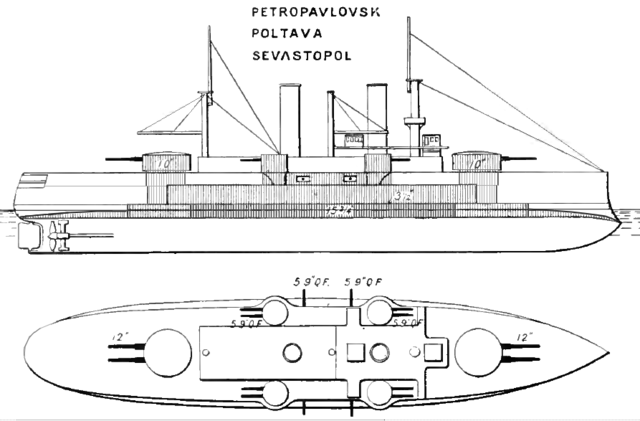
Diagram of Battleship Poltava – Brasseys 1902
Machinery
Their designed specifications also included a top speed of 17 knots (31 km/h; 20 mph), maximum draught of 26 feet (7.9 m) and 3,750 nautical miles (6,940 km; 4,320 mi) range.
They were propelled by two shafts connected to two vertical triple-expansion steam engines from Hawthorn Leslie, the whole system being fed by 14 cylindrical, coal-firing boilers. In total they were rated 10,600 indicated horsepower (7,900 kW). 16 knots as designed were surpassed by Petropavlovsk on trials at 16.38 knots (30.34 km/h; 18.85 mph). Range in wartime allowed 3,750 nautical miles (6,940 km; 4,320 mi) at 10 knots, by carrying 1,050 long tons (1,070 t) each.
These VTE (vertical triple-expansion) steam engines, were fed by 16 boilers on Sevastopol. Their working pressure was 8.8 atm (129 psi), for 10,600 indicated horsepower (7,904 kW). Poltava reached 16.29 knots reach in trials at 11,213 forced heat horsepower. Sevastopol’s powerplant was locally built and on trials she was able to reach only 15.3 knots (28.3 km/h; 17.6 mph) at 9,368 ihp despite having two more boilers.
Armament
There was a revision in design as the first choice was a mix of 6-in and 8-in guns. It was decided in the end to go full 6-in (152 mm). Their designed metacentric height was 5.43 feet (1.7 m) which mad them stable and good seagoing ships.
-Main Guns: These Canet guns were housed in two twin-gun turrets, forward and one aft as usual at the time. They were designed to fire once every 90 seconds, but in reality, this was down to 2.4 min, much lower than many battleships of the time.
-Secondary guns: The battery consisted in twelve Canet 6-in (152 mm) quick-firing (QF) guns, half in twin-gun turrets placed on the sides and the remainer in unprotected embrasures on the sides of the hull amidships.
-Tertiary armament comprised twelve single 47 mm (1.9 in) Hotchkiss guns and twenty-eight single Maxim 37 mm (1.5 in) guns. The Maxims, also called QF 1-pounder pom-pom were recently developed to fire on approaching torpedo boats. They had a ~300 rpm (cyclic) rate of fire, with a Muzzle velocity of 1,800 ft/s (550 m/s) and a practical range at 3000 yards and less.
Torpedo armament: The battleships carried two caliber of torpedo tubes, four 15-inch (381 mm) torpedo tubes above water and two 18-inch (457 mm) torpedo tubes underwater also on the broadside. In addition 30 mines could be carried, stored on deck rails and dropped at the stern.
A Career cut short by the Russo-Japanese war
all three ships after completion were transferred to the Pacific Squadron from 1900, based at Port Arthur. Four years later the Russo-Japanese War abbreviated their career as all three ships participated in the Battle of Port Arthur on the second day of the war.
Petropavlovsk survived only to sink two months later, hitting mines laid by the Japanese. Sevastopol and Poltava took part in the Battle of the Yellow Sea in August 1904. They survived, although crippled, and took refuge in the harbor, to be sank or scuttled at the end of the Siege of Port Arthur when the Japanese, having secured the heights, started pounding the area.
If Sevastopol was a total constructive loss, the Poltava was salvaged by the Japanese and incorporated into the Imperial Japanese Navy as Tango. In Japanese service, she participated in the Battle of Tsingtao in late 1914 but now as an ally of the triple entente she was sold back to the Russians in 1916. The latter renamed her Chesma to free her name for a dreadnought, and she became the flagship of the Russian Arctic Flotilla in 1917.
By then her fate took a new twist as she fell in the hands of the Bolsheviks among the crew. However Chesma was in allied area, and was soon seized back the British in early 1918. Abandoned and left without crew she was left unharmed, not scuttled, only to be seized back by the red army. Due to their age they decided to scrap her in 1924.
Petropavlovsk
The three units were sent to the Pacific fleet, their intended operation area. At Port Arthur, Petropavlovsk and her sister-ships were the spearheads of the fleet, bearing the mark of Admiral Makarov. The Petropavlovsk attempted a raid off Port Arthur at the beginning of the Russo-Japanese war but hit a mine (of unknown origin – the Russians also laid mines).
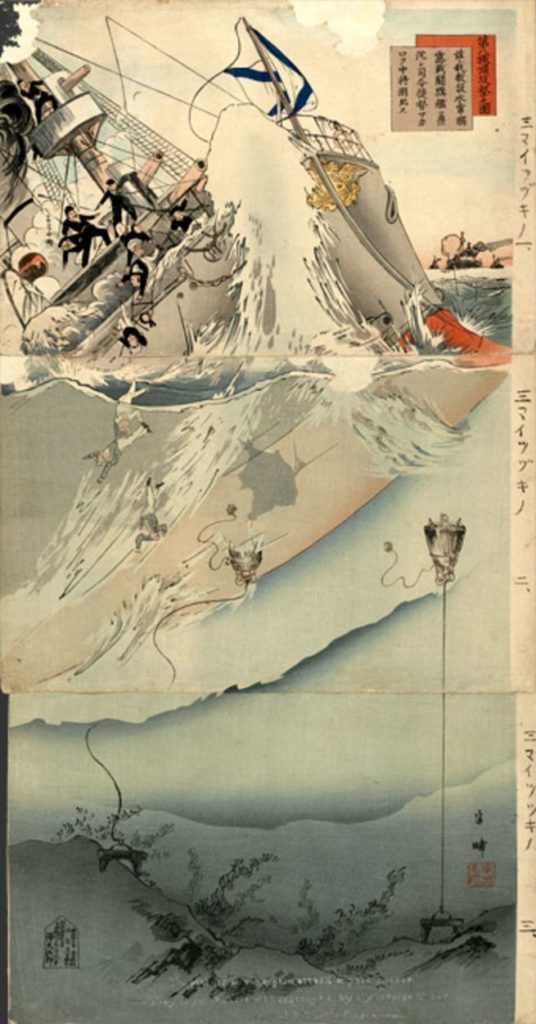
Sevastopol
while the other two were hit hard during the Battle of the Yellow Sea. Refugees at Port Arthur, they were shelled by Japanese Howitzer of the siege army. What was left of a devastated Sevastopol was scuttled in the harbor on January 2, 1905.
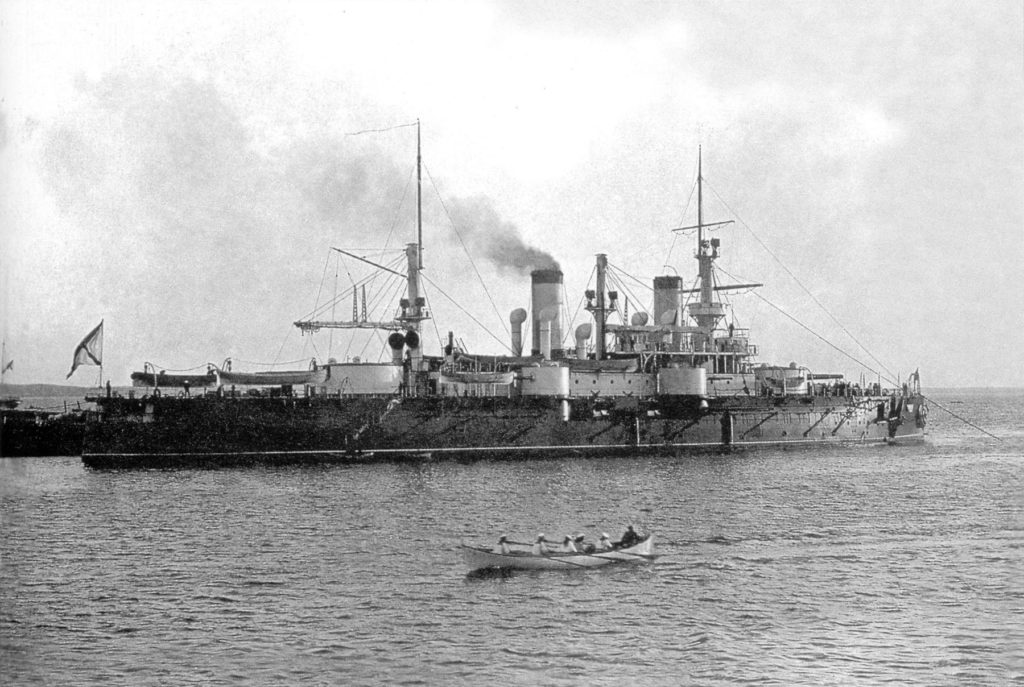
Sevastopol at Kronstadt in 1900
Poltava (Tango, Chesma)
The only survivor of the class, the Tchesma, was formerly laid down as Poltava, from a name of a famous victory in 1709 against Sweden, between Peter the Great and King Charles XII. She was was the first Russian battleship to use Krupp cemented armor from Germany. Perhaps more than other battleships of the same class, the Poltava suffered shortages of skilled workmen, many design changes and delivery of the main armament after a long delay, making her schedule slipping until construction time reached six years; Altough not obsolete by that time, the advantage of her protection was already commonplace. After her last trials ended in 1899 she was sent to the Baltic fleet, together with Sevastopol and she was the first Russian battleships fitted with a Radio, by September 1900, in the Russian Navy.
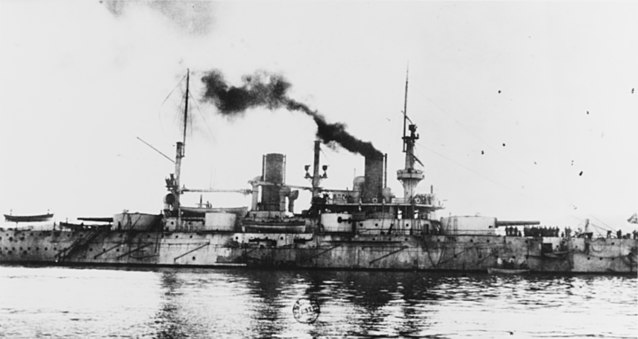
1905: The Poltava at war
The two sister ships departed both on 15 October for Port Arthur but had to stop at the Suez Canal in order to unload their equipment, ammunitions, fuel and supplies in order to reduce their draft enough to slip through. Poltava eventually reached Port Arthur on 12 April 1901, and Sevastopol joined her the following day.
During the night of 8/9 February 1904, IJN destroyers made their famous surprise attack. Poltava mairaculously escape any torpedo ht, so she was ready to make a sortie the following morning. However the IJN Combined Fleet (Vice Admiral Tōgō Heihachirō) catch her after being spotted by the protected cruiser Boyarin. Tōgō at first shelled coastal defenses with main guns, only engaging Russian ships with his secondary guns. This was a poor decision as well-protected Poltava was hit several times with little effect. In return, she fired 12x 12-in and 55x 6-inch shells on the Japanese. Both fleets withdrew and the Poltava was back in Port Arthur for summary repairs and providing care to three wounded sailors.
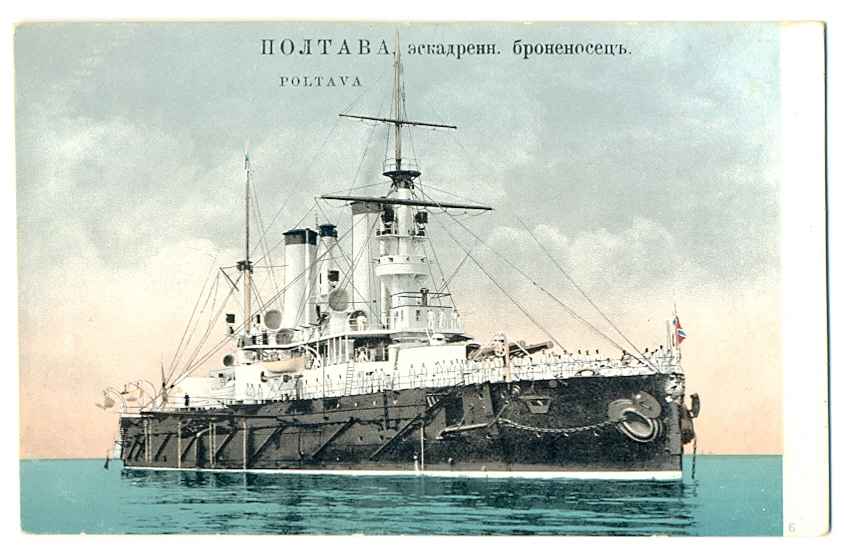
On 13 April, Tōgō successfully lured out a part of the Russian Pacific Squadron, but Vice-Admiral Makarov (Petropavlovsk) spotted the five Japanese battleships and turned back o safety but doing so and his flagship struck a mine and sank in two minutes. Tōgō went on shelling Port Arthur while the Russian sorties at night to lay more minefields, which will claim two IJN battleships in May.
Rear Admiral Wilgelm Vitgeft took command of First Pacific Squadron and sortied for Vladivostok on 23 June, but was interepted by the IJN squadron and turned back. Meanwhile, Poltava led a fleet of cruisers and destroyers to shell Japanese coastal poistions on 9 July 1904. She engaged Japanese ships on her return but failed to sink any while being only slightly damaged. She would land the same month many of her 47 mm and 37 mm guns to bolster the port’s defensive lines against Japanese troops.
On 10 August, Wilgelm Vitgeft thrown all his assets in another desperate attempt to reach Vladivostok, this time in force. The IJN combined fleet waiting for him engaged the battle line in what became the Battle of the Yellow Sea. The duel started shortly after 12:55. Poltava was sixth in line, and at 14:45 she started duelling with Asahi. However soon Mikasa turned her guns on Poltava too. The duel went on, Poltava damaging Mikasa and the cruiser Nisshin.
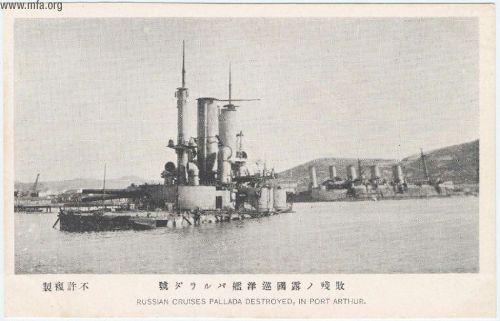
However the Japanese broke off around 15:20 and turned to starboard, creating a gap to make their gunnery accuracy talk but mostly for a brief respite, exert damage control, distribute supplies and taking care of the wounded. At around 17:35 they came back to gunnery range and the duel resumed, this time concentrating on the back of the line, where Poltava was. The latter was hit several times, but Turret problems made the Japanese retire again to work out these problems. They went back at 18:30, Shikishima and Asahi concentrating fire on Poltava. When flagship Tsesarevich’s conning tower was obliterated, the vice admiral was killed and orders no longer came. The crippled battleship turned, followed by the entire squadron, which had severe consequences on opening their line and weakening their own firepower.
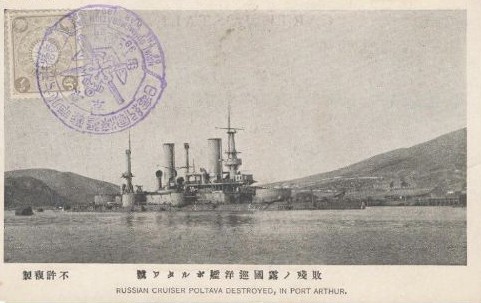
Poltava had to manoeuver tighlty to avoid hitting the now stationary, crippled flagship, and the line was in disarray at least until Rear Admiral Prince Pavel Ukhtomsky took command and ordered the line to return to Port Arthur; But only Pobeda, Sevastopol, Pallada and Poltava catch the signals, the others missed them and it took some time for them to realize what they had to do. Meanwhile Poltava was hit by a further 12-14 12-in shells, mostly directed at her superstructures, loosing most of her secondary batteries. Poltava, Tsesarevich and Peresvet eventually limped back to Port Arthur under siege.

All three battleships at anchor in Port Arthur
The last phase of this episode was dictated by the siege. Japanese Third Army led by Baron Nogi Maresuke eventually took a good firing position and carried there 120 mm howitzers that could fire indirectly on the anchored ships. Poltava therefore was hit on 18 August. However by September she resumed firing on Japanese positions, spending nearly her entire 12-in ammo supply and a large part of the 6-in one. Three of her guns has been deposed to reinforce the defensive lines, as the remainder of her tertiary artillery.
In October 1904 however, the Japanese managed to bring 280 mm howitzers on the coast and started to shell the harbor at will. Poltava was hit twice. Worst still, in December the capture of 203 Meter Hill, allowed the Japanese to bring their artillery in direct fire positions, overlooking the harbor. Soon afterwards they shelled the Poltava, taking five hits, three penetrating the deck and setting ablaze the torpedo room and aft 47 mm magazine. But fire damage control proved impossible as the flooding system was damaged and the fire spread to the ammo room, making the propellant charges for the 12-in shells explode. This tore down a gaping hole in the hull bottom, and the ship sank straight in 45 min. Fortunately without massive casualties. Port Arthur capitulated on January 1905.
New career as IJN Tango
Japanese engineers refloated Poltava on 22 July, after much preparatory work. She was sent for repairs and rearmament at Maizuru Naval Arsenal, and renamed Tango, an ancient Japanese province (Kyoto prefecture) as a 1st class battleship. On 29 August she was officially back into service. She participated in a review of captured ships on 23 October 1905 and later returned for extra repairs and refits until November 1907 and later at Yokosuka Nyd.
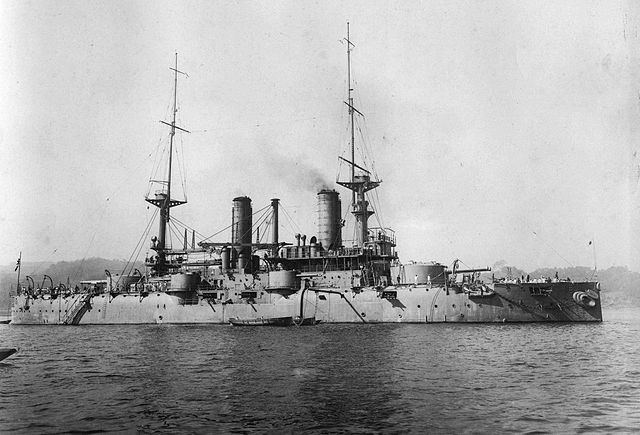
Modifications included the removal of the fighting tops, 16 Miyabara water-tube boilers were installed, the 12-in breeches were replaced by Japanese-built ones, the four 152 mm guns in casemates were replaced by six Japanese 150 mm/45 guns and the light armament revised to ten QF 12-pounder 12 cwt and four 37 mm Hotchkiss, four 18-in aw Torpedo Tubes while the crew was now 668. This long refitting prevented her to be active again until 1911.
Chesma in WW1
She was not long classed as a first-line battleship, re-classified as a 1st class coast defense ship in 1912. She participated the next year in large scale exercizes and afer the war broke out, she was part of the 2nd Squadron (Vice Admiral Kato Sadakichi). She joined a combined fleet sailing to Tsingtao, coordinating her fire with the Imperial Japanese Army, destroying German fortifications. The Germans surrendered on 7 November 1914.
Return to motherland Russia as Chesma
In 1916, the Japanese and Russians were allies against the central Empires. Since the Tsar desperately needed to reinforce the Baltic and Black Seas fleets, he asked the Japanese government to sell back Russia their former captured ships. Therefore Tango departed for Vladivostok, arriving on 2 April while the following day her name was changed to Chesma (after the 1770 battle) when a new crew took her and the Russian Imperial ensign was raised again. She joined later the Allied fleet off Salamis, pressuring the Greeks to surrender their fleet to the allies.
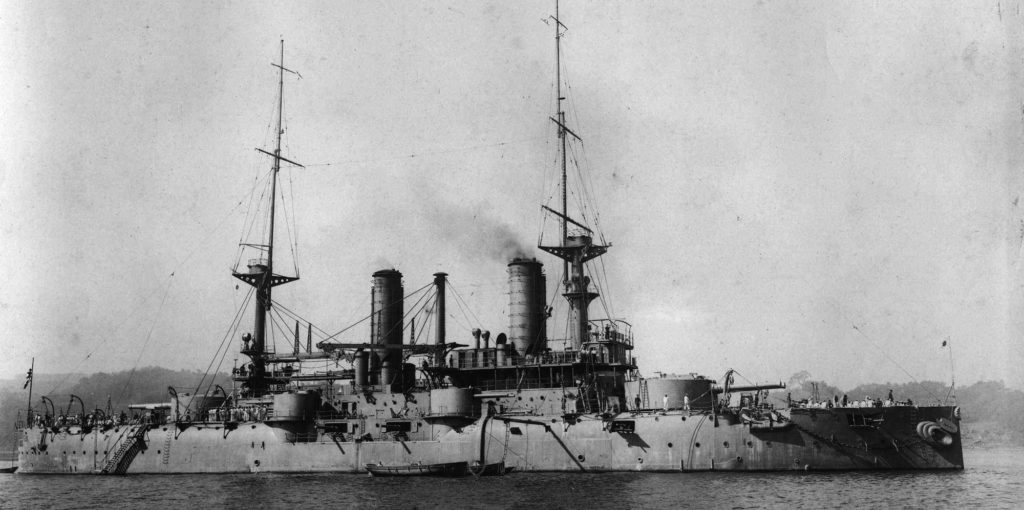
In December 1916, Chesma sailed out of the Mediterranean up to UK for her machinery to be overhauled at Birkenhead (Cammell Laird yard), while her main deck 150 mm and 12-pdr were removed. She would receive four anti-aircraft guns and was back to Aleksandrovsk, Murmansk Oblast, on 16 January 1917. Soon the revolution of February broke out and meanwhile she was assigned to the White Sea Fleet. Her crew eventually rebelled and took control. But her poor state and management made her inactive when Allied landed at Murmansk in March 1918. She was captured by British troops which converted her as a floating prison in April 1919 for Bolshevik prisoners. She was abandoned and re-captured by the Red Army in March 1920. But her state was such she was sent to Archangelsk on 16 June 1921 and stricken in 1924, broken up soon afterwards.
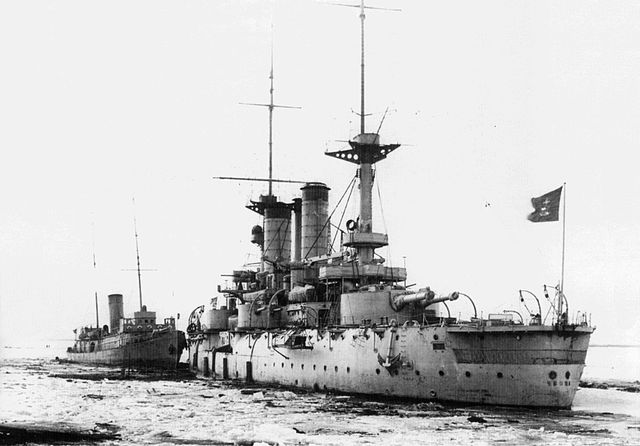
Chesma in 1921
Specifications
Displacement: 11,350 t standard
Dimensions: 112.70 x 21.3 x 7.8 m
Propulsion: 2 shaft VTE, 16 cylindrical boilers, 11,250 hp. and 16.5 knots max.
Armour: Blockhouse: 203, Decks: 50-76, Belt: 370, Turrets: 305-254-120 mm
Crew: 630
Armament: 4 x 305 mm (12 in), 8 x 152 mm (6 in), 2 x 76 mm AA (3 in).
Links, sources
https://en.wikipedia.org/wiki/Petropavlovsk-class_battleship
http://www.fr.naval-encyclopedia.com/1ere-guerre-mondiale/marine-russe1914.php#cuirasses
Conways all the world’s fighting ships 1860-1905
Author’s illustration of the Chesma

 Latest Facebook Entry -
Latest Facebook Entry -  X(Tweeter) Naval Encyclopedia's deck archive
X(Tweeter) Naval Encyclopedia's deck archive Instagram (@navalencyc)
Instagram (@navalencyc)





 French Navy
French Navy Royal Navy
Royal Navy Russian Navy
Russian Navy Armada Espanola
Armada Espanola Austrian Navy
Austrian Navy K.u.K. Kriegsmarine
K.u.K. Kriegsmarine Dansk Marine
Dansk Marine Nautiko Hellenon
Nautiko Hellenon Koninklije Marine 1870
Koninklije Marine 1870 Marinha do Brasil
Marinha do Brasil Osmanlı Donanması
Osmanlı Donanması Marina Do Peru
Marina Do Peru Marinha do Portugal
Marinha do Portugal Regia Marina 1870
Regia Marina 1870 Nihhon Kaigun 1870
Nihhon Kaigun 1870 Preußische Marine 1870
Preußische Marine 1870 Russkiy Flot 1870
Russkiy Flot 1870 Svenska marinen
Svenska marinen Søværnet
Søværnet Union Navy
Union Navy Confederate Navy
Confederate Navy Armada de Argentina
Armada de Argentina Imperial Chinese Navy
Imperial Chinese Navy Marinha do Portugal
Marinha do Portugal Mexico
Mexico Kaiserliche Marine
Kaiserliche Marine 1898 US Navy
1898 US Navy Sovietskiy Flot
Sovietskiy Flot Royal Canadian Navy
Royal Canadian Navy Royal Australian Navy
Royal Australian Navy RNZN Fleet
RNZN Fleet Chinese Navy 1937
Chinese Navy 1937 Kriegsmarine
Kriegsmarine Chilean Navy
Chilean Navy Danish Navy
Danish Navy Finnish Navy
Finnish Navy Hellenic Navy
Hellenic Navy Polish Navy
Polish Navy Romanian Navy
Romanian Navy Turkish Navy
Turkish Navy Royal Yugoslav Navy
Royal Yugoslav Navy Royal Thai Navy
Royal Thai Navy Minor Navies
Minor Navies Albania
Albania Austria
Austria Belgium
Belgium Columbia
Columbia Costa Rica
Costa Rica Cuba
Cuba Czechoslovakia
Czechoslovakia Dominican Republic
Dominican Republic Haiti
Haiti Hungary
Hungary Honduras
Honduras Estonia
Estonia Iceland
Iceland Eire
Eire Equador
Equador Iran
Iran Iraq
Iraq Latvia
Latvia Liberia
Liberia Lithuania
Lithuania Mandchukuo
Mandchukuo Morocco
Morocco Nicaragua
Nicaragua Persia
Persia San Salvador
San Salvador Sarawak
Sarawak Uruguay
Uruguay Venezuela
Venezuela Zanzibar
Zanzibar Warsaw Pact Navies
Warsaw Pact Navies Bulgaria
Bulgaria Hungary
Hungary

 Bundesmarine
Bundesmarine Dutch Navy
Dutch Navy Hellenic Navy
Hellenic Navy Marina Militare
Marina Militare Yugoslav Navy
Yugoslav Navy Chinese Navy
Chinese Navy Indian Navy
Indian Navy Indonesian Navy
Indonesian Navy JMSDF
JMSDF North Korean Navy
North Korean Navy Pakistani Navy
Pakistani Navy Philippines Navy
Philippines Navy ROKN
ROKN Rep. of Singapore Navy
Rep. of Singapore Navy Taiwanese Navy
Taiwanese Navy IDF Navy
IDF Navy Saudi Navy
Saudi Navy Royal New Zealand Navy
Royal New Zealand Navy Egyptian Navy
Egyptian Navy South African Navy
South African Navy






























 Ukrainian Navy
Ukrainian Navy dbodesign
dbodesign